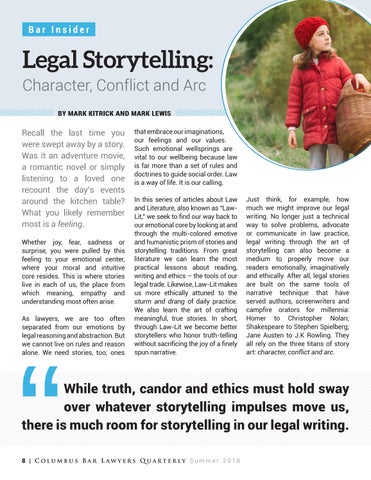Bar Insider
Legal Storytelling: Character, Conflict and Arc bY Mark Kitrick and Mark Lewis Recall the last time you were swept away by a story. Was it an adventure movie, a romantic novel or simply listening to a loved one recount the day’s events around the kitchen table? What you likely remember most is a feeling. Whether joy, fear, sadness or surprise, you were pulled by this feeling to your emotional center, where your moral and intuitive core resides. This is where stories live in each of us, the place from which meaning, empathy and understanding most often arise. As lawyers, we are too often separated from our emotions by legal reasoning and abstraction. But we cannot live on rules and reason alone. We need stories, too; ones
that embrace our imaginations, our feelings and our values. Such emotional wellsprings are vital to our wellbeing because law is far more than a set of rules and doctrines to guide social order. Law is a way of life. It is our calling. In this series of articles about Law and Literature, also known as “LawLit,” we seek to find our way back to our emotional core by looking at and through the multi-colored emotive and humanistic prism of stories and storytelling traditions. From great literature we can learn the most practical lessons about reading, writing and ethics – the tools of our legal trade. Likewise, Law-Lit makes us more ethically attuned to the sturm and drang of daily practice. We also learn the art of crafting meaningful, true stories. In short, through Law-Lit we become better storytellers who honor truth-telling without sacrificing the joy of a finely spun narrative.
Just think, for example, how much we might improve our legal writing. No longer just a technical way to solve problems, advocate or communicate in law practice, legal writing through the art of storytelling can also become a medium to properly move our readers emotionally, imaginatively and ethically. After all, legal stories are built on the same tools of narrative technique that have served authors, screenwriters and campfire orators for millennia: Homer to Christopher Nolan; Shakespeare to Stephen Spielberg; Jane Austen to J.K Rowling. They all rely on the three titans of story art: character, conflict and arc.
While truth, candor and ethics must hold sway over whatever storytelling impulses move us, there is much room for storytelling in our legal writing. 8 | Columbus Bar L aw yers Quarterly Summer 2018
